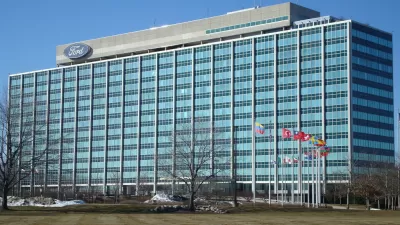The downfall of the American auto industry is also having a major impact on middle and working class African-American families. This piece from the The New York Times Magazine looks at the connection.
As much as one-fifth of workers in the American auto industry are African-American. This piece looks at the rise and fall of the two.
"The story of the rise of America's black working and middle classes is inextricably bound up with that of Detroit and the Big Three. It is not a story with a simple upward trajectory. For a long time, blacks were relegated to the least desirable jobs in the plants and initially confined to a small ghetto on the East Side of the city. But slowly, haltingly, over the course of the 1950s and early '60s, the plants became fully integrated and black workers spread across Detroit block by block, moving the city's de facto color line as they went. 'It wasn't that long ago that Detroit was the home of the nation's most affluent African-American population with the largest percentage of black homeowners and the highest comparative wages,' David Goldberg, an African-American Studies professor at Wayne State University, told me.
Autoworkers still make up much of what is left of Detroit's black middle class, but their numbers are shrinking fast."
FULL STORY: G.M., Detroit and the Fall of the Black Middle Class

Maui's Vacation Rental Debate Turns Ugly
Verbal attacks, misinformation campaigns and fistfights plague a high-stakes debate to convert thousands of vacation rentals into long-term housing.

Planetizen Federal Action Tracker
A weekly monitor of how Trump’s orders and actions are impacting planners and planning in America.

In Urban Planning, AI Prompting Could be the New Design Thinking
Creativity has long been key to great urban design. What if we see AI as our new creative partner?

King County Supportive Housing Program Offers Hope for Unhoused Residents
The county is taking a ‘Housing First’ approach that prioritizes getting people into housing, then offering wraparound supportive services.

Researchers Use AI to Get Clearer Picture of US Housing
Analysts are using artificial intelligence to supercharge their research by allowing them to comb through data faster. Though these AI tools can be error prone, they save time and housing researchers are optimistic about the future.

Making Shared Micromobility More Inclusive
Cities and shared mobility system operators can do more to include people with disabilities in planning and operations, per a new report.
Urban Design for Planners 1: Software Tools
This six-course series explores essential urban design concepts using open source software and equips planners with the tools they need to participate fully in the urban design process.
Planning for Universal Design
Learn the tools for implementing Universal Design in planning regulations.
planning NEXT
Appalachian Highlands Housing Partners
Mpact (founded as Rail~Volution)
City of Camden Redevelopment Agency
City of Astoria
City of Portland
City of Laramie



























